Bengaluru Couple With 250 Plants Shares How to Grow Gourds & Beans on Your Terrace
Bengaluru-based urban gardeners Vijay Narasimha and his wife Vasundra Narasimha grow 26 varieties of vegetables on their terrace, under a canopy of gourds.
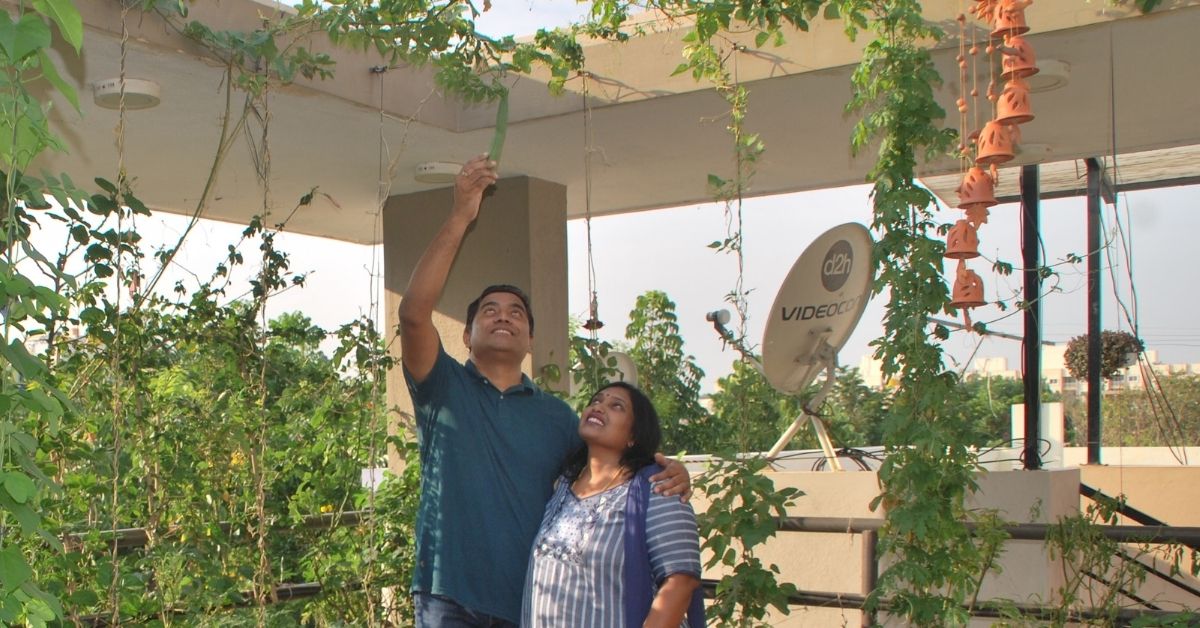
Every morning as the sun rises, Bengaluru-based Vijay Narasimha (43) and his wife Vasundra Narasimha (41) are on their terrace sipping a cup of coffee, speaking to their 250 plants. They are not farmers or retired folks. They are merely working professionals who live in Jalahalli and are ardent lovers of plants and gourds.
Such is their passion, three years ago, when constructing their home, they ensured it could house plants too.

“Having a terrace garden that can provide vegetables and herbs necessary for daily use has been our dream. Earlier, we were living in a rented apartment and hence could not utilize space there. But, when we began to construct our home, we coordinated with the architect and ensured to provide enough space for placing plants. On the terrace, we placed raised platforms so that it would be easy for maintenance,” says Vijay.
Last year, the duo also had Galvanised Iron (GI) wires installed over their roof as vines for creepers such as bitter gourd, long gourd, ridge gourd, snake gourd, and beans to grow on. This not only creates enough space for the plants to grow on the terrace but also gives an aesthetically pleasing finish to their house.
“It was done with the help of external labour. Apart from the wire on top, we used ropes to support growth from the pots. Today, we harvest three vegetables every week, and when there is excess, we share with the neighbours too.”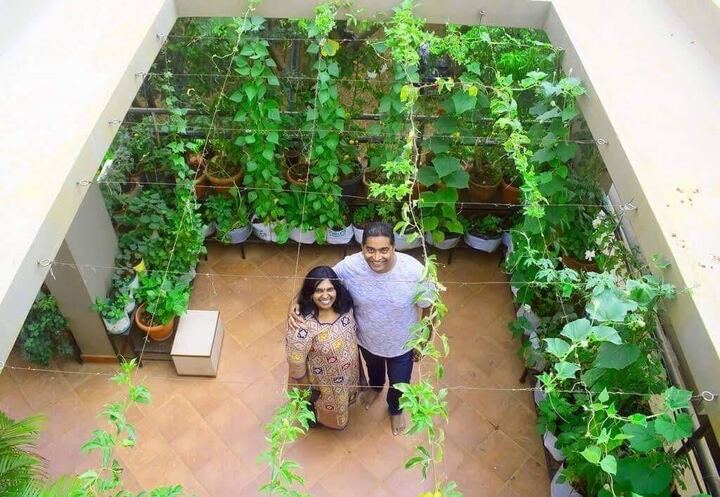
According to Vasundra, growing gourds requires time, patience, and sometimes pollination too.
Here’s how they did it:
- Preparing the container, soil, and seedling
First, they prepared the desired container for planting seeds or seedlings.
The duo used a recycled container and ensured that there were provisions for excess water to drain.
Then, Vijay had planted seedlings purchased from a vegetable nursery. The seedlings were planted in an organic potting mix made using vermicompost and dried leaves.
While planting seedlings, Vijay says that he ensured the soil was loose and not sticky.
- Providing trainer ropes for support
Once the seedling started to grow, from the same container, trainer ropes were attached to support the creepers. These trainer ropes led to the GI wires that were laid on top.
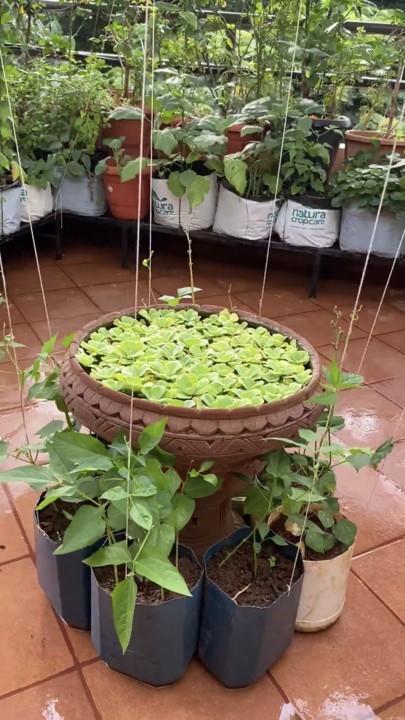
- Hand pollination of the flowers
In a few weeks, once flowers started to show up on the plant, Vasundra identified the male and female flowers to hand-pollinate them.
“Female flowers have a small fruit-formation right behind them, and male flowers will not have this. Using a paintbrush or cotton earbud, the pollen from the male flower should be dusted onto the female flower. This process is to be done in the morning hours,” says Vasundra adding that sometimes bees can take care of this process, but on terrace gardens, it is unlikely that pollination will take place naturally.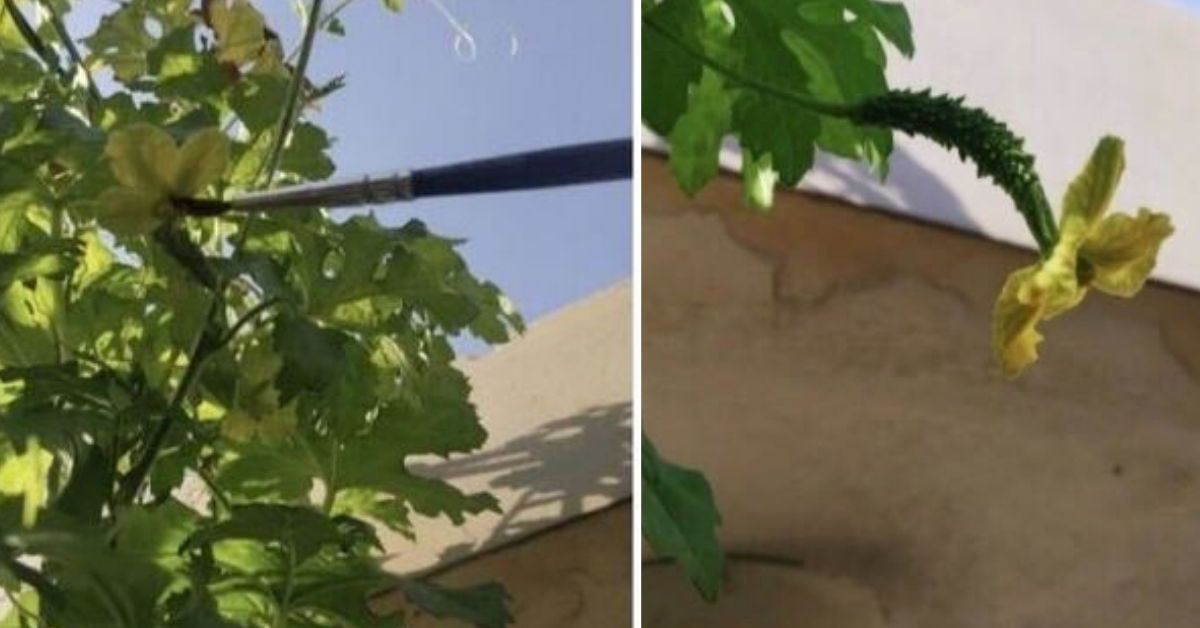
Vijay and Vasundra say that you can use the method to grow your own gourds.
If you do not have provision to add GI wires to your roof, you can add support using ropes or poles to let the creeper grow.
But here are some things to remember:
- The gourds must be watered regularly.
- If you are planting using seeds instead of seedlings, it is important to germinate them first.
- The seedlings must be planted in containers that provide 12 inches of space for the roots to grow.
- Initially, male flowers are produced, and female flowers appear after.
- Keeping track of the blooming time is important as the flowers will wither after a few days.
- Every 20 days add compost to the containers from where the gourds are growing. This will help the plant to grow better.
- To prevent any disease from spreading onto the plant, Vijay suggests pruning them or spraying neem oil.
A spacious terrace garden
On their 400 square feet terrace, Vijay and Vasundra have lined up 250 flower pots, grow bags, recycled bottles, and cans. Some water bottles are attached to a hook on the wall, to create the look of a hanging garden. The rest are placed around the terrace.
“The water bottles are cut open at the centre, and a few holes are punctured at the bottom. Then, we fill it with soil, some vermicompost for nutrition, and plant the seeds or seedlings for the herbs. Apart from growing in plastic water bottles, I also used 5-litre cans to grow some varieties of spinach.”
The raised platform to place their pots and containers not only helped them keep their terrace clean, but also ensured enough space for them to place chairs and create a sit-out amidst their garden.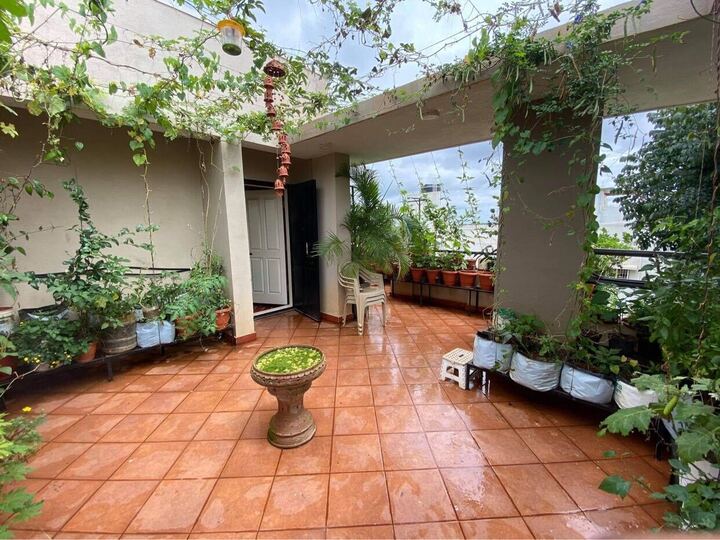
To ensure their terrace attracts natural pollinators – bees, the duo also grows flowering plants ranging from hibiscus to chrysanthemums. Vasundra’s parents, who live with them, use the flowers for their daily prayers.
Currently, the duo is harvesting 26 varieties of vegetables other than gourds, including cabbage, cauliflower, chillies, bell peppers, zucchini, and tomatoes. They also grow leafy vegetables like amaranthus and methi, herbs like amruthavalli, coriander, mint, basil, and more.
Lockdown woes soothed
“Growing food on the terrace has helped to shorten our food chain. After coming across horror stories about sewage used to grow leafy vegetables and herbs, we decided to become self-sufficient. For the last three years, we have only vegetables required in large quantities like onions, garlic, ginger, and sometimes tomatoes from the supermarket. Our terrace garden provided us with all vegetables we needed during the lockdown,” says Vasundra.
For the future, the duo plan to grow exotic varieties of herbs like rosemary and lemongrass.
If you wish to know more about Vijay and Vasundra’s garden you can follow them on Facebook or youtube.
(Edited by Vinayak Hegde)
This story made me
- 97
- 121
- 89
- 167
Tell Us More
We bring stories straight from the heart of India, to inspire millions and create a wave of impact. Our positive movement is growing bigger everyday, and we would love for you to join it.
Please contribute whatever you can, every little penny helps our team in bringing you more stories that support dreams and spread hope.



















